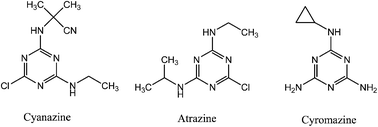Selective screening of trace trazine herbicides in tomato samples employing dummy molecularly imprinted solid-phase extraction coupled with liquid chromatography
Abstract
A highly selective dummy molecularly imprinted

* Corresponding authors
a
Key Laboratory of Pharmaceutical Quality Control of Hebei Province & College of Pharmacy, Hebei University, Baoding, China
E-mail:
yanhy@hbu.edu.cn
Fax: +86-312-5971107
Tel: +86-312-5971107
A highly selective dummy molecularly imprinted

 Please wait while we load your content...
Something went wrong. Try again?
Please wait while we load your content...
Something went wrong. Try again?
F. Wang, H. Yan, R. Wu, T. Cai, K. Han and Z. Li, Anal. Methods, 2013, 5, 2398 DOI: 10.1039/C3AY40145F
To request permission to reproduce material from this article, please go to the Copyright Clearance Center request page.
If you are an author contributing to an RSC publication, you do not need to request permission provided correct acknowledgement is given.
If you are the author of this article, you do not need to request permission to reproduce figures and diagrams provided correct acknowledgement is given. If you want to reproduce the whole article in a third-party publication (excluding your thesis/dissertation for which permission is not required) please go to the Copyright Clearance Center request page.
Read more about how to correctly acknowledge RSC content.
 Fetching data from CrossRef.
Fetching data from CrossRef.
This may take some time to load.
Loading related content
